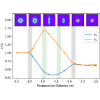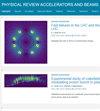Collisional simulations of the modulator section in coherent electron cooling
IF 1.8
3区 物理与天体物理
Q3 PHYSICS, NUCLEAR
Physical Review Accelerators and Beams
Pub Date : 2024-04-05
DOI:10.1103/physrevaccelbeams.27.044401
引用次数: 0
Abstract
The first section of any coherent electron cooling (CeC) system is the modulator, where the density of the electron beam is modulated by the copropagating ion beam. This density modulation is a result of Coulomb collisions between the individual particles of the two beams. The pairwise, stochastic part of the interactions impacts the overall performance of the CeC process. We present the first simulations of the density modulations of the electron beams from a collisional picture of the dynamics, considering the proof-of-principle CeC experiments at Brookhaven National Laboratory. These simulations were performed using PHAD, which is the first efficient, large-scale collisional numerical method in beam physics that we have previously developed and benchmarked. Realistic beam distributions and external fields have been optimized to provide strong modulation signals necessary for variations of coherent electron cooling systems. Cooling performance limits and potential collisionless simulation pitfalls are pointed out.

相干电子冷却中调制器部分的碰撞模拟
相干电子冷却(CeC)系统的第一部分是调制器,在这里电子束的密度受到共传播离子束的调制。这种密度调制是两束电子束中单个粒子之间库仑碰撞的结果。相互作用的成对、随机部分会影响 CeC 过程的整体性能。考虑到布鲁克海文国家实验室(Brookhaven National Laboratory)的原理验证 CeC 实验,我们首次从碰撞动力学的角度模拟了电子束的密度调制。这些模拟是使用 PHAD 进行的,PHAD 是我们之前开发和基准测试的首个高效、大规模碰撞数值方法。对真实的束流分布和外部场进行了优化,以提供相干电子冷却系统变化所需的强调制信号。指出了冷却性能的限制和潜在的无碰撞模拟陷阱。
本文章由计算机程序翻译,如有差异,请以英文原文为准。
求助全文
约1分钟内获得全文
求助全文
来源期刊

Physical Review Accelerators and Beams
Physics and Astronomy-Surfaces and Interfaces
CiteScore
3.90
自引率
23.50%
发文量
158
审稿时长
23 weeks
期刊介绍:
Physical Review Special Topics - Accelerators and Beams (PRST-AB) is a peer-reviewed, purely electronic journal, distributed without charge to readers and funded by sponsors from national and international laboratories and other partners. The articles are published by the American Physical Society under the terms of the Creative Commons Attribution 3.0 License.
It covers the full range of accelerator science and technology; subsystem and component technologies; beam dynamics; accelerator applications; and design, operation, and improvement of accelerators used in science and industry. This includes accelerators for high-energy and nuclear physics, synchrotron-radiation production, spallation neutron sources, medical therapy, and intense-beam applications.
 求助内容:
求助内容: 应助结果提醒方式:
应助结果提醒方式:


